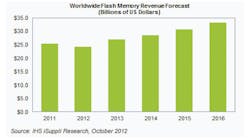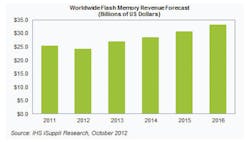An anticipated decline in worldwide flash memory revenues this year will give way to improvement in 2013 and beyond, according to analysts looking at end-of-year results across the industry. Electronics industry research and analysis firm IHS iSuppli projects more than $24 billion in flash memory market revenues by the end of this year, with the NAND segment accounting for nearly $21 billion and the NOR sector making up the remainder. That’s slightly below 2011 levels, but the outlook is for more than 11% growth in 2013, followed by 5% compound annual growth through 2016 (see the figure).
In an October report, IHS attributed the growth in large part to the mobile handset market, which is demanding more powerful memory as handset manufacturers seek to refresh their products with the latest features and processors. Growing demand for cellular phones worldwide is driving the trend, as consumers seek the newest innovations in smart-phone technology and emerging economies create demand for both high-end and low-end phones.
Chipmakers are responding with products that meet manufacturers’ needs for more power and smaller size. Last month, Samsung announced a new advanced memory storage solution for slim smart phones and tablets. The company’s next-generation 64-Gbyte embedded multimedia card (eMMC) uses 10-nm class process technology. The product went into production in late October, and Samsung said it will be submitted next year to JEDEC (Joint Electron Engineering Council) for adoption as an industry standard.
Samsung is applying 64-Gbyte high-performance NAND memory using its 10-nm class technology to the new 64-Gbyte eMMC Pro Class 2000 memory solution. The new embedded memory solution exceeds the performance levels of its earlier product—the conventional 64-Gbyte eMMC Pro Class 1500, based on an eMMC 4.5 interface—by 30%. The eMMC Pro Class 1500 was introduced just five months earlier than the Pro Class 2000.
Samsung says it will build on the new technology to develop its line of embedded memory solutions.
“We look forward to expanding our lineup of embedded memory solutions in conjunction with the new chip’s design in pursuing a system-level adoption of application processors and other key components that form the foundation for the most advanced mobile platforms,” said Myungho Kim, vice president of memory marketing, device solutions, for Samsung Electronics. “This will allow us to better attend to time-to-market demands, enabling the design of more convenient features for next-generation mobile applications.”
As demand for such NAND applications grows, NOR continues to lose ground, falling as much as 28% in quarterly year-over-year comparisons this year. IHS attributes the segment’s trouble to the wireless sector, where it is being squeezed by lower-cost NAND-based solutions emulating NOR capabilities.
“NOR, which blossomed in the early years of the handset business, continues to be used in lower-cost cell phones, despite ongoing market share losses in its total market to rival NAND,” the IHS report stated. “NAND flash, meanwhile, is enjoying high demand as consumers migrate to smart phones, in which data storage in the phones takes advantage of NAND cost, scale, and die size.”
Smart phones are expected to account for 54% of the total cell-phone market in 2013, up from 46% in 2012 and 35% in 2011, IHS predicted earlier this year. This will mark the first time the smart-phone market will represent more than 50% of cell-phone shipments.









